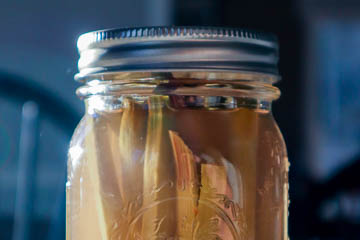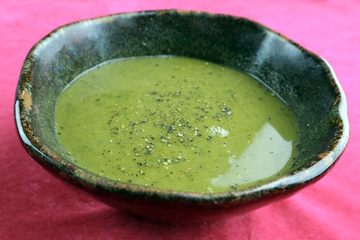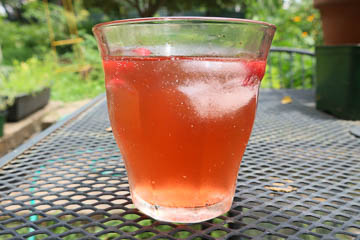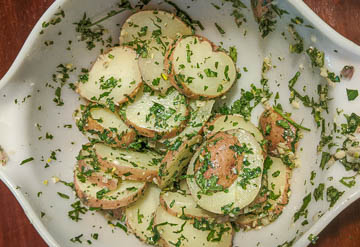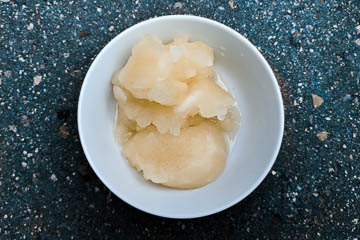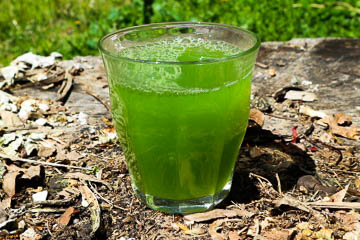Jump to Recipe ↓
Fermentation is a wonderful vehicle for transformation; transforming humble cabbage into a tangy, umami-rich side, transforming inert vegetables into a probiotic paradise, even transforming bitter garlic mustard leaves into a pleasant, garlicky seasoning!
Garlic mustard is a much-maligned invasive plant that is filled to the brim with flavor and nutrition! Although the leaves can seem unpleasantly bitter when raw, a quick trip through the fermentation machine unlocks their unbeatable flavor combo of garlic and mustard while completely diminishing their bitterness. By eating fermented garlic mustard you are helping the environment by harvesting an invasive plant and helping your body by providing it with probiotics and nutrients!
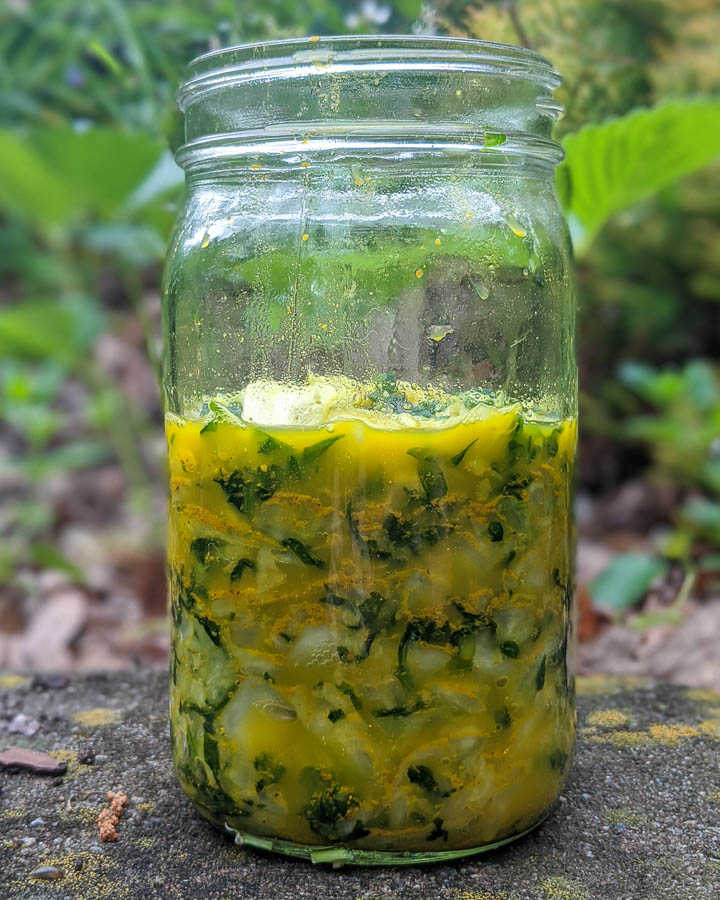
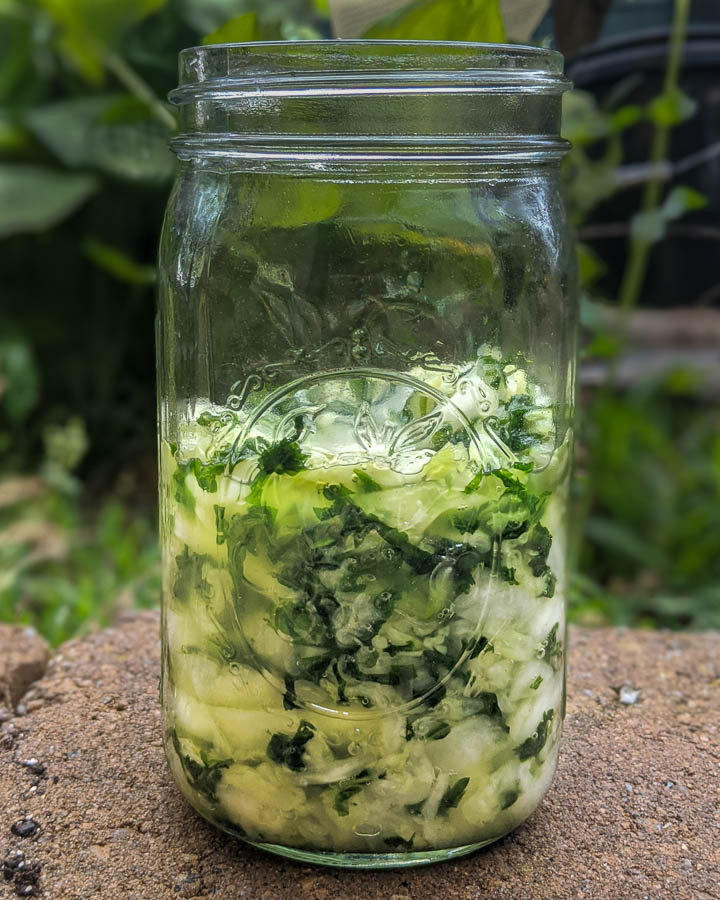
Curried Garlic Mustard Sauerkraut Recipe
This recipe is inspired by local botanist Marc Williams. At the end of a soggy plant walk at a local farm, Marc brought out an unassuming jar of sauerkraut to help dry our dampened spirits. After a hefty taste (and re-taste) I was certain that the kraut contained garlic and maybe chickweed since it was so mild. I was shocked to find out that it was seasoned simply by garlic mustard, the notorious bitter weed growing at the edge of the forest.
A few years later I adapted Pascal Baudar's "DandiKraut" recipe from Wildcrafted Fermentation and I've been enjoying garlic mustard sauerkraut ever since! It's okay to use bitter garlic mustard leaves here.
Curried Garlic Mustard Kraut Recipe
- Makes: about 2 cups of sauerkraut
- Active time: 20 minutes
- Passive time: 10-14 days
Garlic Mustard Sauerkraut Ingredients
- 2 cups firmly packed (2 ounces) destemmed garlic mustard leaves
- 6 cups firmly packed (1 pound) chopped cabbage (from a roughly 1 ½ pound cabbage)
- 11 grams (roughly 2 teaspoons) iodine-free salt
- 1 Tablespoon curry powder (optional)
Garlic Mustard Sauerkraut Directions
- Chiffonade (finely slice) the garlic mustard leaves. Take a handful of leaves and roughly stack them one on top of the other like a pile of papers. Roll them tightly into a plant cigar, then slice the cigar crosswise to create thin strips of the leaves. Repeat with the remaining leaves. Place the garlic mustard in a large bowl and set aside.
- Slice the cabbage. First, remove any unsavory-looking leaves from the cabbage, such as the outer pair or two. Slice the head into quarters and remove the core from each quarter. Slice the remaining cabbage into bite-sized strips, or as desired. Weigh out 1 lb of the sliced cabbage and place into the bowl with the garlic mustard.
- Soften the cabbage. Add the salt to the bowl with the cabbage. Massage the garlic mustard and cabbage mixture for about 10 minutes. This helps break down the cell walls in the cabbage to release its sweet cabbagey tears which will form the base of the brine. Once the cabbage is soft and pliable and about ½ cup of juice has puddled into the bottom of the bowl, stir in the curry powder, if using, and mix thoroughly.
- Pack the cabbage mixture into a clean jar. (A quart mason jar will work nicely.) Place a handful of the cabbage mixture into the jar, then pack down firmly with your fist, eliminating as many air bubbles as possible. Repeat with the remaining cabbage. Pour the remaining brine on top. Cover with a lid making sure that it is tight enough to keep out any fruit flies, but loose enough to let fermentation gases escape.
- Pay attention to the ferment. Stir 1-3 times per day for the first 3-4 days, or until fermentation becomes very active. Use a clean fork to rough up the top few inches of cabbage, then push it back under the surface of the brine. Cover with a lid, tightly but not too tightly. After the cabbage is vigorously fermenting, about 3-4 days, it is no longer necessary to stir up the ferment once a day.
- Finish the sauerkraut. For the rest of the total 10-14 days, make sure to burp the jar once a day until it stops producing fermentation gasses. Once it stops producing gases or is adequately sour, move the kraut into the fridge where it will last for a few months.
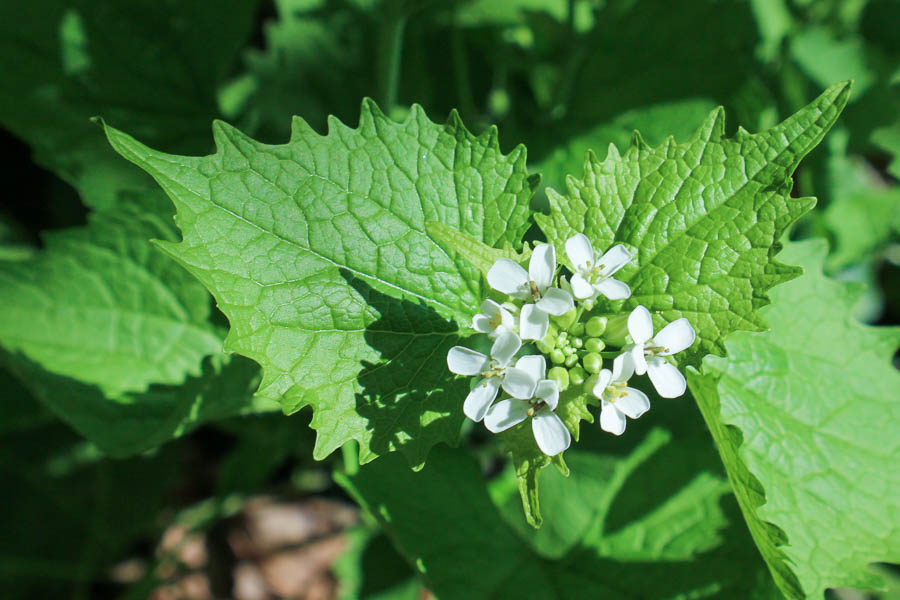 Garlic mustard in flower
Garlic mustard in flower
Garlic Mustard Sauerkraut Notes and Substitutions
Curry powder adds a lovely hue to the sauerkraut along with a delightful layering of flavors. Feel free to adjust the amount of curry powder according to the strength of the particular powder you are using. Keep in mind that its flavor will intensify during fermentation.
I recommend making kraut by weight because the variation in flake density between salt varieties such as table salt and coarse flaky sea salt can lead to great variations in salinity in the kraut. It is better to have a ferment that is too salty, than not salty enough.
If you are salting by volume, a good general guideline is that the mixture should taste a hair too salty as you pack it into the jar.
You can easily adapt this salt-cabbage-garlic mustard ratio to fit the amount of cabbage that you have. This is most easily done by weight in grams.
Please note that there are many different styles of fermentation ranging from airlocked jars to ferments that are weighed down with plastic bags. The method presented above is my current favorite way to make self-brining ferments. I encourage you to explore other fermentation methods to find the best fit for you!

ABOUT THE AUTHOR
